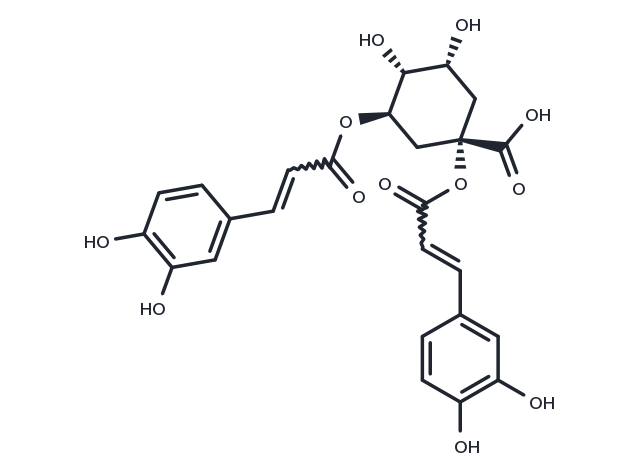Powder: -20°C for 3 years | In solvent: -80°C for 1 year
1,3-Dicaffeoylquinic acid (CYNARIN) is a natural product. It shows antioxidant and choleretic properties and is a potential immunosuppressive agent.

| 説明 | 1,3-Dicaffeoylquinic acid (CYNARIN) is a natural product. It shows antioxidant and choleretic properties and is a potential immunosuppressive agent. |
| In vivo | CYNARIN have neuroprotective effects.CYNARIN prevents Aβ(42)-induced neurotoxicity through the activation of PI3K/Akt followed by the stimulation of Trk A, then the inhibition of GSK3β as well as the modulation of Bcl-2/Bax. |
| 動物実験 | The neuroprotective effects of 1,5-DQA against amyloid β(1-42) (Aβ(42))-induced neurotoxicity in primary neuronal culture. To evaluate the neuroprotective effects of 1,5-DQA, primary cultured cortical neurons from neonate rats were pretreated with 1,5-DQA for 2 hours and then treated with 40 μmol/L Aβ(42) for 6 hours. Cell counting kit-8, Hoechst staining and Western blotting were used for detecting the protective mechanism. Comparisons between two groups were evaluated by independent t test, and multiple comparisons were analyzed by one-way analysis of variance (ANOVA). |
| 植物由来 |
| 別名 | CYNARIN, Cyclohexanecarboxylic acid, 1,3-bis[[3-(3,4-dihydroxyphenyl)-1-oxo-2-propen-1-yl]oxy]-4,5-dihydroxy-, (1S,3R,4R,5R)-, 1,3-O-Dicaffeoylquinic acid, 1,5-Dicaffeoylquinic acid |
| 分子量 | 516.45 |
| 分子式 | C25H24O12 |
| CAS No. | 19870-46-3 |
Powder: -20°C for 3 years | In solvent: -80°C for 1 year
DMSO: 23 mg/mL (44.53 mM)
You can also refer to dose conversion for different animals. 詳細
bottom
Please see Inhibitor Handling Instructions for more frequently ask questions. Topics include: how to prepare stock solutions, how to store products, and cautions on cell-based assays & animal experiments, etc.
1,3-Dicaffeoylquinic acid 19870-46-3 Cytoskeletal Signaling Immunology/Inflammation Metabolism NF-Κb PI3K/Akt/mTOR signaling Reactive Oxygen Species Akt PI3K Phosphoinositide 3-kinase 1,3 Dicaffeoylquinic acid inhibit Protein kinase B Inhibitor 1,3Dicaffeoylquinic acid PKB CYNARIN Cyclohexanecarboxylic acid, 1,3-bis[[3-(3,4-dihydroxyphenyl)-1-oxo-2-propen-1-yl]oxy]-4,5-dihydroxy-, (1S,3R,4R,5R)- 1,3-O-Dicaffeoylquinic acid 1,5-Dicaffeoylquinic acid inhibitor
